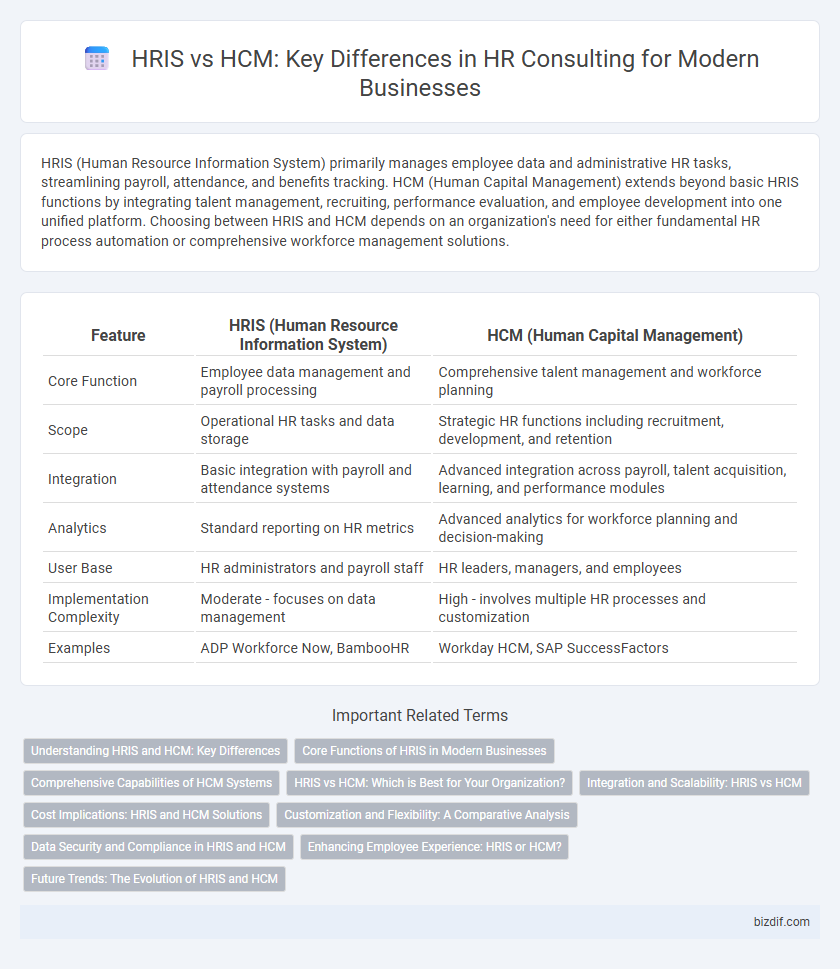HRIS (Human Resource Information System) primarily manages employee data and administrative HR tasks, streamlining payroll, attendance, and benefits tracking. HCM (Human Capital Management) extends beyond basic HRIS functions by integrating talent management, recruiting, performance evaluation, and employee development into one unified platform. Choosing between HRIS and HCM depends on an organization's need for either fundamental HR process automation or comprehensive workforce management solutions.
Table of Comparison
| Feature | HRIS (Human Resource Information System) | HCM (Human Capital Management) |
|---|---|---|
| Core Function | Employee data management and payroll processing | Comprehensive talent management and workforce planning |
| Scope | Operational HR tasks and data storage | Strategic HR functions including recruitment, development, and retention |
| Integration | Basic integration with payroll and attendance systems | Advanced integration across payroll, talent acquisition, learning, and performance modules |
| Analytics | Standard reporting on HR metrics | Advanced analytics for workforce planning and decision-making |
| User Base | HR administrators and payroll staff | HR leaders, managers, and employees |
| Implementation Complexity | Moderate - focuses on data management | High - involves multiple HR processes and customization |
| Examples | ADP Workforce Now, BambooHR | Workday HCM, SAP SuccessFactors |
Understanding HRIS and HCM: Key Differences
HRIS (Human Resource Information System) primarily focuses on core administrative functions such as payroll, benefits administration, and employee data management, providing essential operational support for HR tasks. In contrast, HCM (Human Capital Management) encompasses a broader scope by integrating talent management, workforce planning, and employee development tools, driving strategic HR initiatives and organizational growth. Selecting between HRIS and HCM depends on whether a company prioritizes transactional efficiency or comprehensive workforce optimization.
Core Functions of HRIS in Modern Businesses
HRIS primarily focuses on core functions such as employee data management, payroll processing, benefits administration, and compliance tracking, streamlining routine HR tasks and improving data accuracy. Modern businesses leverage HRIS to centralize workforce information, automate time-consuming processes, and generate analytical reports for strategic decision-making. Unlike broader HCM systems, HRIS emphasizes operational efficiency in handling essential human resource functions.
Comprehensive Capabilities of HCM Systems
HCM systems offer comprehensive capabilities beyond traditional HRIS by integrating talent management, workforce planning, and employee engagement tools within a single platform. These systems facilitate end-to-end employee lifecycle management, combining payroll, benefits administration, performance management, and learning development modules. Advanced analytics and AI-driven insights in HCM solutions support strategic decision-making and align human capital with organizational goals more effectively than standard HRIS platforms.
HRIS vs HCM: Which is Best for Your Organization?
HRIS (Human Resource Information System) primarily manages employee data, payroll, and benefits administration with a focus on transactional and compliance tasks. HCM (Human Capital Management) encompasses HRIS capabilities but extends to talent management, workforce planning, and employee development, offering a strategic approach to workforce optimization. Choosing between HRIS and HCM depends on organizational size, HR complexity, and long-term goals, with HCM being ideal for companies prioritizing integrated talent management and HRIS suitable for basic HR operations.
Integration and Scalability: HRIS vs HCM
HRIS systems offer core HR functions with limited integration capabilities, suitable for small to mid-sized businesses seeking basic employee data management. HCM platforms provide comprehensive, scalable solutions that integrate payroll, talent management, and workforce analytics, supporting complex organizational needs and global operations. The scalability of HCM enables seamless adaptation to business growth and evolving HR processes, while HRIS may require additional modules or third-party tools to achieve similar integration levels.
Cost Implications: HRIS and HCM Solutions
HRIS solutions generally involve lower upfront costs and focus on core HR functions such as payroll and employee records management, making them cost-effective for small to mid-sized companies. HCM systems integrate broader capabilities including talent management, workforce analytics, and employee engagement tools, resulting in higher implementation expenses but offering long-term value through improved strategic HR processes. Organizations must assess budget constraints against desired functionality to determine whether the cost implications of HRIS or HCM systems align with their operational goals and growth plans.
Customization and Flexibility: A Comparative Analysis
HRIS offers fundamental customization options suitable for managing employee data, payroll, and basic reporting, making it ideal for organizations seeking standard HR functionalities with some flexibility. HCM systems provide advanced customization, integrating talent management, workforce planning, and employee engagement tools, allowing for tailored workflows and comprehensive HR processes. The flexibility of HCM supports scalability and evolving business needs, while HRIS typically focuses on core administrative functions with limited adaptability.
Data Security and Compliance in HRIS and HCM
HRIS and HCM systems both prioritize data security and compliance, with HRIS focusing on securely managing employee records and payroll data, adhering to regulatory standards like GDPR and HIPAA. HCM platforms integrate these security measures while offering advanced compliance tracking across talent management, benefits administration, and performance evaluations. Robust encryption, access controls, and audit trails in both systems protect sensitive HR information and ensure adherence to evolving labor laws and privacy regulations.
Enhancing Employee Experience: HRIS or HCM?
HRIS (Human Resource Information System) primarily focuses on managing employee data, payroll, and compliance, offering essential tools for administrative efficiency, while HCM (Human Capital Management) systems extend these capabilities by integrating talent management, employee engagement, and performance analytics to deliver a more holistic employee experience. Companies aiming to enhance employee experience benefit from HCM's strategic approach, which includes learning and development modules, career pathing, and real-time feedback mechanisms that foster engagement and retention. Leveraging HCM solutions drives personalized employee journeys, aligning workforce management with organizational goals and improving overall satisfaction and productivity.
Future Trends: The Evolution of HRIS and HCM
HRIS and HCM systems are evolving rapidly, integrating AI-driven analytics and predictive workforce planning to enhance talent management and employee engagement. Cloud-based platforms and mobile accessibility are becoming standard, ensuring seamless HR operations and data security across global enterprises. The future of HR technology emphasizes personalized employee experiences and real-time decision-making to support strategic business growth.
HRIS vs HCM Infographic

 bizdif.com
bizdif.com